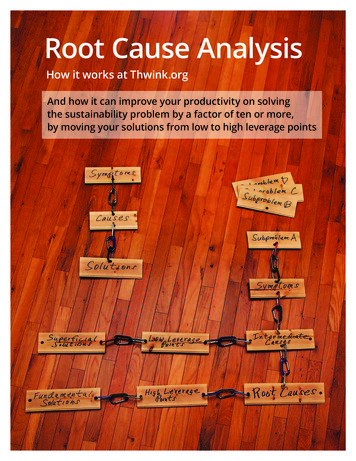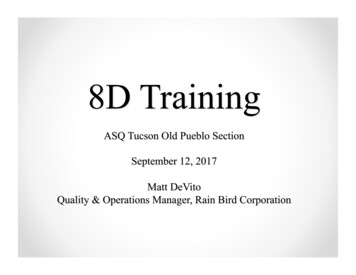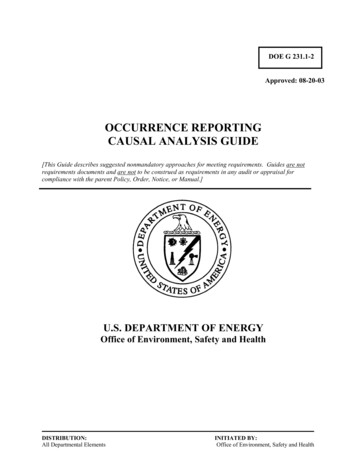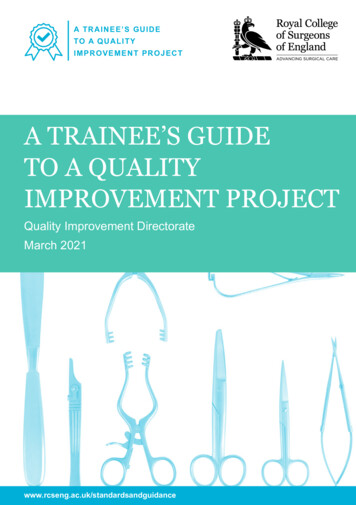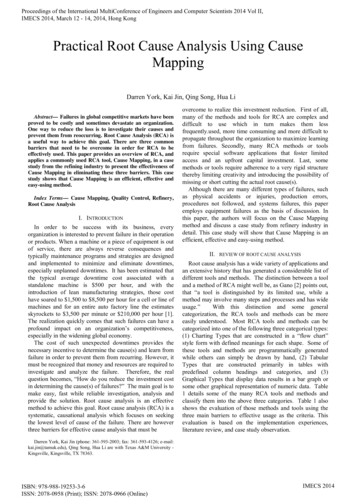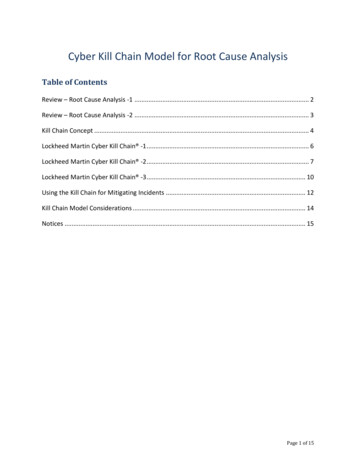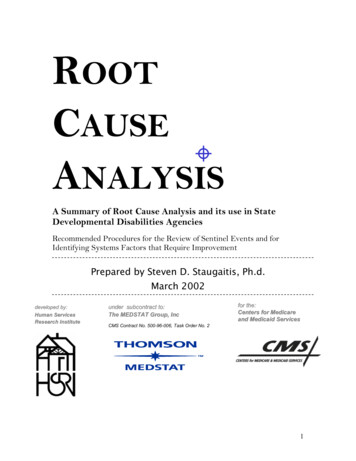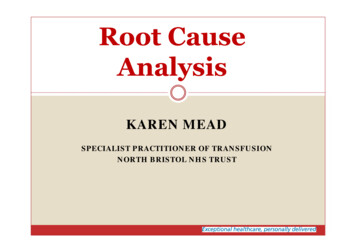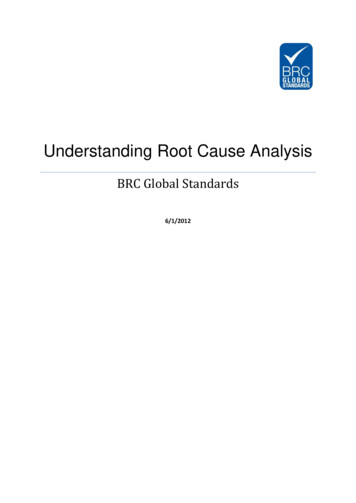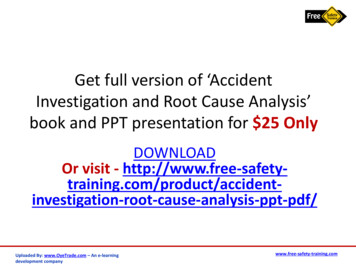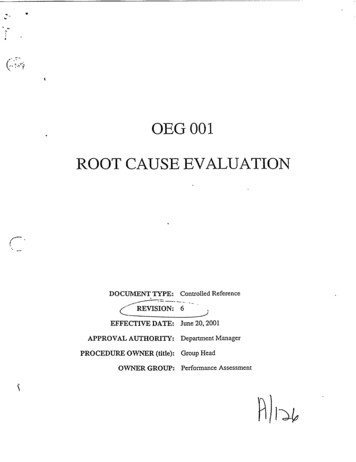
Transcription
OEG 001ROOT CAUSE EVALUATIONDOCUMENT TYPE: Controlled Reference(-REVISION:EFFECTIVE DATE:APPROVAL AUTHORITY:PROCEDURE OWNER (title):OWNER GROUP:6June 20,2001Department ManagerGroup HeadPerformance Assessment1-ýý
:1POINT BEACH NUCLEAR PLANTOE GROUP C UIDEOEG 001Revision 6June 20, 2001ROOT CAUStE EVALUATIONTABLE OF CONTENTSSECTIONTITLE1.0PURPOSE .42.0REFERENCES .43.0DEFINITIONS .44.0PRECAUTIONS .65.0PREREQUISITES .66.0PROCESS .77.0REPORT PREPARATION .148.0ENTRY OF ACTION ITEM S INTO NUTRK .15EQUIPMENT FAILURE ROOT CAUSE .1610.0COMM ON CAUSE ANALYSIS (CCA) .1711.0HUM AN ERROR INVESTIGATIONS .1812.0CORRECTIVE ACTION REVIEW BOARD (CARB) .1913.0EFFECTIVENESS REVIEW S .20EXHIBIT APERSONAL STATEMENT .21EXHIBIT BEVENT AND CAUSAL FACTOR CHARTING .22EXHIBIT CTASK ANALYSIS .26EXHIBIT DINTERVIEW ING .28EXHIBIT ECHANGE ANALYSIS .33EXHIBIT FBARRIER ANALYSIS .35S 9.0EXHIBIT G FAILURE M ODES AND EFFECTS ANALYSIS .PAGE38
POINT BEACH NUCLEAR PLANTOE GROUP GUIDEOEG 001Revision 6June 20, 2001ROOT CAUSE EVALUATIONTABLE OF CONTENTSSECTIONTITLEEXHIBIT HCAUSE AND EFFECT ANALYSIS .41EXHIBIT IPARETO ANALYSIS .42EXHIBIT JTROUBLESHOOTING / FAILURE ANALYSIS .43EXHIBIT K FAULT TREE ANALYSIS .EXHIBIT LPAGE44DEVELOPMENT OF RECOMMENDATIONS FOR CORRECTIVE ACTIONS . 45EXHIBIT M EVENT EVALUATION AND ROOT CAUSE ANALYSISTECHNIQUES APPLICATION GUIDELINE .46EXHIBIT NRCE QUALITY INDEX SCORE SHEET EXAMPLE .47EXHIBIT OE----,EXHIBIT PROOT CAUSE EVALUATION PLANNING GUIDE .49EXHIBIT QEFFECTIVENESS REVIEWS .ROOT CAUSE ANALYSIS PACKAGE COMPLETION CHECKLIST . 5052
POINT BEACH NUCLEAR PLANTOE GROUP GUIDEOEG 001Revision 6June 20, 2001ROOT CAUSE EVALUATION1.0PURPOSEThe purpose of this document is to provide guidance for personnel to effectively identify the rootcause(s) of problems to ensure proper corrective actions to prevent recurrence are implemented.This document provides guidance for an investigator to determine a root cause of an event. It isthe investigators' responsibility to select the most appropriate analysis technique, whethercovered by this guide or not, that will identify the root cause(s).2.03.0REFERENCES2.1INPO 90-004, "Good Practice OE-207, Root Cause Analysis"2.2NP 5.3.1, "Condition Reporting System;'2.3NP 5.3.3, "Incident Investigation and Post-Trip Review"2.4NP 5.4.1, "Open Item Tracking Systems"DEFINITIONS3.1Apparent Cause Evaluation (ACE): An evaluation done to determine the apparentcause (versus a root cause) of an event. An apparent cause evaluation is less rigorous thana root cause evaluation.3.2Causal Factors: The potentially influencing conditions or elements that were presentwhen a condition adverse to quality occurred that may have led to or contributed to theroot or contributing cause(s).3.3Corrective Action (CA): Action taken to restore the adverse condition to an acceptablecondition or capability (Full Qualification), but may not be the only actions needed toprevent recurrence of the condition.3.4Interim Corrective Actions (ICA): Actions taken to reduce the risk of reoccurrencewhile waiting for CAPR.3.5Corrective Action to Prevent Recurrence (CATPR): Action taken to preventrecurrence of a condition or event or to eliminate or minimize the causal factors of thecondition.
POINT BEACH NUCLEAR PLANTOE GROUP GUIDEOEG 001Revision 6June 20, 2001ROOT CAUSE EVALUATION3.6Contributing Cause: Causes that, if corrected would not by themselves have preventedthe event, but are important enough to be recognized as needing corrective action toimprove the quality of the process or product.3.7Immediate Action: Action taken to promptly restore a condition adverse to quality to anacceptable state. After evaluation, additional prompt actions may be required to fullyrestore the deficient condition.3.8Root Cause: Identified cause(s) that, if corrected, will prevent recurrence of a conditionadverse to quality.3.9Root Cause Evaluation (RCE): Evaluation that determines and analyzes the cause(s) ofan inappropriate action or adverse condition, then identifies the Root Cause(s) of theevent.3.10Root Cause Investigator (RCI): A qualified individual assigned by the LineOrganization to perform a root cause evaluation.3.11SCAQ Action: A corrective action that serves to eliminate the root(s) or significantcontributing cause(s) of a Significant Condition Adverse to Quality.3.12Failure Mode: An event causal factor that when identified will help identify the RootCause(s) and Contributing Cause(s) for an event.3.13Common Cause Assessment (CCA): An assessment method used to identify the RootCause(s) and Contributing Cause(s) for a number of similar events. Usually initiatedbased on a declining or adverse trend, the analysis generally uses a variety of statisticalanalyses, interviews, and surveys to help to determine the Root Cause(s) of the adversetrend.3.14Combined Root Cause Evaluation (RCE): More than one apparently similar event isanalyzed in one RCE report. Evaluation determines and analyzes the apparent cause(s) ofan inappropriate action or adverse condition for each report, then identifies the RootCause(s) of the events. Analysis not as extensive as CCA.3.15Equipment Failure Root Cause Evaluation (RCE): An assessment of equipmentfailures where the failure modes are the result of material, design, or similarequipment-related defects or natural phenomenon (e.g., tornado, lightning). This shouldinclude Maintenance Rule failures and should consider Human Error orOrganizationalVProgrammatic Breakdown failure modes.
POINT BEACH NUCLEAR PLANTOE GROUP GUIDEOEG 001Revision 6June 20, 2001ROOT CAUSE EVALUATION4.0 5.0PRECAUTIONS4.1Preservation of physical evidence and important information is necessary to determineroot causes. Investigators should plan activities so that physical evidence and otherimportant information is not altered, destroyed, or lost. Preservation of evidence must notinterfere with or delay placing the plant or systems in a safe condition.4.2The root cause investigator must not become distracted by event recovery activities.Investigators should communicate effectively with recovery team members, but stayfocused on investigation and root cause analysis.4.3A root cause investigator should refer to this guide as appropriate, while performingevaluations. The intent of the guide is to improve the efficiency and effectiveness ofevaluations.4.4A Root Cause Evaluation (RCE) requires a parent NUTRK document to track correctiveactions.PREREQUISITESIf it has been decided that the event is a Level A condition, Management should appoint a teamleader who will assemble the investigation team. A team charter shall be established, containingthe following elements: The expectations of the team should be defined.0 The scope of the investigation shall be consistent with the severity of the event.*The authority of the team shall be defined in relation to scope changes, priority of interviews,commanding internal and external support services, etc.If it has been decided that the event is a Level B condition, an individual root cause investigatorshould be assigned to perform the root cause.If a reactor trip has occurred, Operations personnel will have obtained initial information andstatements per NP 5.3.3, Incident Investigation and Post-Trip Review. Obtain copies of thisinformation to support your evaluation.
POINT BEACH NUCLEAR PLANTOE GROUP GUIDEOEG 001Revision 6June 20, 2001ROOT CAUSE EVALUATION6.0 PROCESS6.1PreparationInitiate the preparation process as soon as practicable after the evaluation is assigned. Thefollowing points should be helpful to the investigator to better plan the evaluation."* Determine the scope of the evaluation with the appropriate line manager."* When planning the evaluation, consider who should be interviewed and any scheduleconstraints that may impact the interviews (e.g., shift workers)."* If support from another department is involved, give them early notification." Give early consideration to the need to correspond with outside organizations such asvendors, EPRI, other utilities, etc., if needed to support the evaluation. Sometimesinformation requests and inquiry responses can take several days or weeks. NOMISand Nuclear Network are two industry information exchange media for requestinginformation from other utilities who may have experienced similar events."* Identify or define the station acceptable performance criteria that meets or exceedsapplicable Industry Standards and Regulations."* If performing an RCE on an incident that involves chemicals or chemical processes,contact Industrial Health and Safety to ensure compliance with OSHA 1910.6.2Exhibit 0 provides an example of a planning checklist that can be used to work out theschedule of completing the RCE. Approximate average industry time for completion of aRCE is as follows:Estimated Man-hours:"* Common Cause 100 - 700 (Hours may vary greatly based on extent of problem/sizeof team)."* Root Cause 40 to 80 (significant management review and revision may extend this).n-7 "rCI
POINT BEACH NUCLEAR PLANTOE GROUP GUIDEOEG 001Revision 6June 20, 2001ROOT CAUSE EVALUATION6.3Information Gathering6.3.1The investigator should gather information and data relating to theevent/problem. This includes physical evidence, interviews, records, anddocuments needed to support the root cause. Some typical sources ofinformation which may be of assistance include the following:"* Operating logs"* Maintenance records"* Inspection reports"* Procedures and Instructions"* Vendor Manuals"* Drawings and Specifications"* Equipment History Records" Strip Chart Recordings"* Trend Chart Recordings"* Sequence of Event Recorders" Radiological Surveys"* Plant Parameter Readings"* Sample Analysis and Results"* Correspondence"* Design Basis Information"* Photographs/Sketches of Failure Site" Industry Bulletins"* Previous CRs/Root Cause Evaluation Reports (RCEs)"* NPRDS Records"* Turnover logs for affected groups (e.g., HP, Maintenance)"* Task sheets"* Lesson plans* NUTRK Trend Data, including OE Narrow Issue Trending Data.NOTE:Statements should be obtained prior to any critique which could alter theperceptions of those involved whenever possible.6.3.2Use Exhibit A, "Personnel Statement," or a similar form to obtain writtenstatements from personnel involved as soon as practical (preferably prior toleaving the site) following the event. Personnel statements are normallywritten separately by each individual rather than as a collaborative summaryof the event.,-,C,nrX
POINT BEACH NUCLEAR PLANTOE GROUP GUIDEOEG 001Revision 6June 20, 2001ROOT CAUSE EVALUATION6.4NOTE:Construction of an Event and Causal Factor Chart should begin as soonas information becomes available. Even though the initial event sequenceand timeline may be incomplete, it should be started early in theevaluation process.6.3.3Construct an Event and Causal Factor Chart that shows the order in whicheach action of the event occurred. This can most easily be done by compilingall input information (e.g., interviews, written statements, evaluation results)and placing them in chronological order. A Task Analysis may be useful inconstructing the Event and Causal Factor Chart. See Exhibit B, "Event andCausal Factor Charting," and Exhibit C, "Task Analysis."6.3.4Conduct personnel interviews with involved parties as soon as practicalfollowing the event. See Exhibit D, "Interviewing."6.3.5If it is suspected that the cause of the event may have been an intentionalattempt to disrupt normal plant operation (e.g., tampering), notify Station andNuclear Operations management and the Director of Corporate Security inaccordance with applicable station procedures.Analyzing InformationNOTE:These are not the only methods available, but represent proventechniques for evaluating various types of problems.6.4.1Using the facts identified by the evaluation, and reviewing the event as awhole, decide which of the facts or groups of facts are pertinent. Analyticaltechniques that may be helpful include:"*"*"*"*"*"*"*Change Analysis (Exhibit E)Barrier Analysis (Exhibit F)Failure Modes and Effects Analysis (Exhibit G)Cause and Effects Analysis (Exhibit H)Pareto Analysis (Exhibit I)TroubleshootingfFailure Analysis (Exhibit J)Fault Tree Analysis (Exhibit K)6.4.2Compare the facts to an "acceptable standard" and determine if anunacceptable condition exists. Identify each inappropriate action andequipment failure.6.4.3Review the PBNP RCE list and identify previous and current investigationsthat may influence your evaluation or your corrective actions. Search thecorrective action program database for key words or similar What, Who, andWhy codes that could identify other related issues, past or present. Review thecorrective actions from these other events and determine how effective theywere in preventing or mitigating recurrence of the event.Pie() of 54
POINT BEACH NUCLEAR PLANTOE GROUP GUIDEOEG 001Revision 6June 20, 2001ROOT CAUSE EVALUATIONNOTE:If you're reading this note you should take 5 minutes to contact theCorrective Action Program Group and have them establish your NuclearNetwork access. They can show you how to conduct a search. Noevaluator should be without it!6.4.4The Nuclear Network can be used to identify similar events or OEinformation. Searches performed using this network are easy and efficient.Why not identify industry standards or validate your proposed solutionsagainst proven programs at other sites? If you still can't find answers justplace your question on the network and watch how fast the system works. TheOE Coordinator can also help with searches.6.4.5Review the corrective actions from other events or OE evaluations anddetermine how effective they were in preventing the recurrence or mitigatingthe outcome of the current event. Consider whether any corrective actions stillin progress could have prevented the event or mitigated the outcome of theevent.NOTE:All RCEs should address "EXTENT OF CONDITION." Ask thequestion, "Could this condition be lurking out there some where else?" Ifit is truly isolated and not applicable to anything else, state it explicitly inyour report. Otherwise we need to determine the extent of the conditionor how we will determine the extent. An easy example would be a CR onelectronics data in tables being corrupted. Clearly, it could affect allprocedures which had been converted from Word Perfect to MicrosoftWord. We are going to look at them all to see if there are others withproblems. A harder example would be the recent RCE on issues with theAux Feed not being able to take a single failure after a tornado. Untilrecently, we didn't consider this to be part of our design basis. Are thereother systems out there that could be susceptible to single failures aftertornadoes/seismic events?6.4.6Ensure similar components or documents are examined to determine theextent to which the unacceptable condition exists.6.4.7Evaluate potential detrimental effects on associated plant equipment.6.4.8Organize the information into an overall description of the problem.6.4.9Establish a start time and a finite end time to the event.6.4.10Determine the nuclear safety significance of the event. This may requireformal analysis of the event by the Probabilistic Risk Assessment (PRA)group. PRA should be contacted early in the investigation as appropriate.1"N.I n- C, r4
POINT BEACH NUCLEAR PLANTOE GROUP GUIDEOEG 001Revision 6June 20, 2001ROOT CAUSE EVALUATION6.4.116.5Occasionally, more than one apparently similar event is analyzed in one RCEreport. The evaluation should use the analysis techniques described above todetermine and analyze the pertinent facts, extent of condition, failuremode(s), etc., of the inappropriate action or adverse condition for each eventor issue, then identify the root cause(s). Each event needs to be consideredseparately first as the causes may actually not be related at all (for example,three storage tanks failing over the course of a month may sound similar witha potential common root cause, but one might be due to a system lineupcausing overpressurization, one due to a tornado, one due to corrosion). It isimportant to ensure that all issues and corrective actions required by theindividual CRs or RCEs are addressed in the final report.Root Cause Determination6.5.1Once the Event and Causal Factor Chart has been constructed, it may benecessary to break down the sequence of events further to determine causaland contributing factors that led to each inappropriate action or equipmentfailure. Root cause(s) will be determined from the causal factors.NOTE:The PII Charts with codes are located in Electronic file;U:\DATA\COMMON\TEMPiichart.doc6.5.2The failure modes (causal factors) should be determined by using the PIIExecutive Management Failure Mode Chart (EMFMC), Organizational &Programmatic Diagnostic Chart (OPDC), and Human Error Failure ModeCharts (HEFMC). Each failure mode must be supported by facts determinedin the investigation. Not all facts may necessarily lead to a failure mode; also,multiple facts may lead to a single failure mode and individual facts may leadto multiple failure modes.6.5.3Organizational & Programmatic (O&P) issues may initially be identifiedduring interviews, but the issues should be verifiable through factualinformation such as procedures, process maps (PII OPIC charts),regulations, etc.T-,---I I-'rCA
POINT BEACH NUCLEAR PLANTOE GROUP GUIDEOEG 001Revision 6June 20,2001- ROOT CAUSE EVALUATIONNOTE:Normally, more than one failure mode is involved with an event. Thefailure mode is not a Root Cause, but a means to help determine the rootcause(s).6.5.4Once all the failure modes are identified determine the potential Causes bystream analysis. Using a copy of the P11 chart, for each failure modeidentified, draw lines to the other failure modes that it "caused;" then drawlines to the failure mode from each of the others that it was "caused by."When all cause-effect relationships have been identified, count how manylines go out from and into each box on the chart. Failure modes with the mostlines going out are causes, the ones with the most coming in are effects(although they may also be causes); the failure mode with the most should berelated to the root cause. This is a graphical analysis similar to the analysis inthe next step.6.5.5For each causal factor identified, ask the following questions until the rootcause(s) is determined (see Exhibit H, "Cause and Effect Analysis").* What caused this?0 Why does this condition exist?6.6Root Cause Determination and Validation6.6.1Once the causes of an event have been identified, take action to ensure that thecorrection of the causes will prevent recurrence.NOTE:If a cause does not meet all three of the required criteria but meets 1 or 2,then it is considered a "significant contributing" cause.6.6.2Each root cause should meet the following three criteria:"* The problem would not have occurred had this cause not been present."* The problem will not recur due to the same cause if it is corrected oreliminated."* Correction or elimination of the cause(s) will prevent recurrence of similarconditions.,. -.r:'
POINT BEACH NUCLEAR PLANTOE GROUP GUIDEOEG 001Revision 6June 20, 2001ROOT CAUSE EVALUATIONNOTE:Solutions will often require the implementation of various actions depending onrequired plant conditions or resource availabilitya Corrective Action (CA)- action taken to restore full qualification. Interim Corrective Actions (ICA)- actions taken to reduce the risk ofreoccurrence while waiting for long term CATPR.* Corrective Action to Prevent Reoccurrence (CATPR) - actions taken topreclude reoccurrence of the adverse condition.NOTE:6.7Use caution not to utilize corrective actions that call for "assess", "evaluate","consider", "review", etc. This is to minimize the likelihood of no correctiveactions being implemented. RCEs which contained actions for assessment orevaluation of existing practices or programs have typically ended up with noactual changes being made.Corrective Action Development6.7.1Solutions must be identified and implemented that will correct the identifiedroot cause(s)6.7.2Brainstorming, and interviewing are good sources of ICAs/CATPRs andinvolve people to establish ownership as early as possible. SeeExhibit L, "Development of Recommendations For Corrective Actions."6.7.3Apply the following criteria to CATPRs to ensure they are viable. * *6.7.4Will these CATPRs prevent recurrence of the problem?Are the CATPRs within the capability of Point Beach to implement in acost effective manner?Do the CATPRs allow Point Beach to meet its primary objectives-ofsafety and consistent electrical generation?Will the implementation of the CATPRs result in meeting or exceedingapplicable industry standards.Assign priorities to the corrective actions commensurate with the significanceof the condition present.(Refence NP 5 4.1, Attchment B)6.7.5Obtain "buy-in" from the Group Head or Manager of the group that will beresponsible for performing the corrective action.6.7.6If the investigator, sponsor, or a group responsible for implementingcorrective actions is unable to reach agreement, the CAP Manager willfacilitate a resolution. When necessary, CARB will provide the finalresolution.
POINT BEACH NUCLEAR PLANTOE GROUP GUIDE---OEG 001Revision 6June 20, 2001ROOT CAUSE EVALUATION7.06.7.7Investigators assist Groups in establishing the implementation conditions andresources. Accurate due dates (completion dates), require adequate planningand dedication of group resources. Your report must reflect this commitment.When appropriate identify ICA(s) which will be implemented while waitingfor CATPR(s).6.7.8Corrective actions should be specific and address each cause. Correctiveactions too narrowly focused, unless appropriate, may not correct the rootcause such that similar events are prevented. Corrective actions that are toobroad or more extensive than the causes would imply may be an attempt to"shotgun" the cause or to use the RCE to correct pet peeves. In the long run,this could prove costly and create the potential for another event.REPORT PREPARATIONNOTE:7.1You can find a template for the RCE report format atU:ADATA\COMMON\TEMI\RCEREPORTTEMPLATEThe RCE report should contain the following:.a cover page with a title, the CR/QCR and LER (if appropriate) associated withthe event, the date of the event, and the names of the investigator(s).0an executive summary which includes:1. the purpose or of the evaluation2. a brief summary of the event3. the safety significance of the event4. major causes (root and contributing)5. major corrective actions6. reports to external agencies*an event narrative. a section for an extent of condition assessment (generic implications) including:1. internal events2. external OE*a section for reports to external agencies:1. NRC, DNR, EPA, Insurance, etc.2. consideration for reporting to INPO*a data analysis section*a summary of the root and contributing causes and corrective actions withresponsible groups and due datesPbýr-IAitn
POINT BEACH NUCLEAR PLANTOE GROUP GUIDEOEG 001Revision 6June 20, 2001ROOT CAUSE EVALUATIONa section for nuclear safety significance which should include:1. actual safety, potential nuclear safety (e.g., unable to fulfill design basisfunction). NOTE that this may require input from Licensing, Engineering, orProbabilistic Risk Assessment (PRA).2. personnel safety (actual or potential)3. environmental safetyan events and casual factors chart7.2After the RCE report is drafted, the cognizant managers and potentially affectedpersonnel should be given the opportunity to review and comment on the draft report inits entirety prior to finalization.7.3The draft of the RCE should be given to the RCE Coordinator prior to final approval forreview in accordance with the Root Cause Analysis Quality Index (RCQAI). This indexassesses RCE quality according to a set of questions that can be compared againstindustry results. This index will produce a score for the RCE and provides for feedbackof specific comments to the RCI. Any RCE not scored prior to approval will be scoredafter approval and distribution. (See Exhibit N)7.4The cover page of the RCE will contain the signature and date of the Issue Manager,Corrective Action Manager, and when directed by the CAP Manager, other managers thatmay be significantly affected.7.5When the RCE has been approved by the appropriate managers, it is routed to the RCECoordinator. The RCE Coordinator shall review the RCE and CAP database to ensurecorrective actions have been entered. If corrective actions have not been entered, the RCECoordinator will notify the PLA that the RCE is approved and corrective actions shouldbe entered.7.6The RCE Coordinator shall distribute the evaluation to all PBNP Section Heads, Off-SiteReview Committee, and, depending on the event issue, other appropriate personnel.NOTE:7.78.0Entry of corrective actions into the CAP database is independent of CARBreview.The RCE is considered approved when the appropriate managers sign the cover sheet. Assoon as the RCE is approved, close the evaluation associated with the RCE and notify thePLA to enter corrective actions in the CAP database.ENTRY OF ACTION ITEMS INTO NUTRKCR/QCR PLA will ensure that corrective actions for "root" and "significant contributing" causesare tracked via the CAP database in accordance with NP 5.3.1.
POINT BEACH NUCLEAR PLANTOE GROUP GUIDE- -',OEG 001Revision 6June 20, 2001ROOT CAUSE EVALUATION9.0,EQUIPMENT FAILURE ROOT CAUSE.The depth to which the equipment failure root cause analysis is taken is based on the safety andeconomic significance of the failure. See Exhibit M for possible techniques to use.9.1Quarantine or preserve the failed equipment so that evidence is not destroyed ordisturbed.9.2Determine potential failure modes.9.3Develop a testing plan that utilizes the failure modes chart to prove or refute all thepossible causes. The testing plan should prevent destruction of evidence as much aspossible for future testing and should detail the expected resulting possibilities.9.4Through the testing sequence different failure modes should be eliminated. The goal is toeliminate all but one failure mode. The failure mode should determine the root cause.9.5If testing shows that multiple event failure modes have taken place in the same event,then each must be considered for root cause and corrective actions should be applied toeach unique root cause.9.6In these evaluations, the following additional items should be considered during theinvestigation. Findings in each of the items below must be provided in the final report:0*a*0**Current Operability Determination or evaluation.Reportability evaluation.Transportability evaluation.Industry Operating Experience (OE) review.Internal Operating Expei-ence (OE) review.Vendor experience/input.Organizational & Programmatic Deficiencies/Human Error contribution.9.7Investigation of the failure mode may require laboratory analysis. Many of these testresults must be compared to the original design specifications to determine if the criticalcharacteristics of the failed item meet design requirements. Tolerances should beincluded as this will often identify a mis-manufactured item.9.8Successful equipment failure root cause is heavily dependent on a thorough andsystematic evaluation of technical data. After collecting the data, perform simple analysesto eliminate possible scenarios. Watch for human error or programmatic problems.Consult experts as required.-"Crr
POINT BEACH NUCLEAR PLANTOE GROUP GUIDEOEG 001Revision 6June 20, 2001ROOT CAUSE EVALUATION10.QCOMMON CAUSE ANALYSIS (CCA)10.1Data Collection (from CRs, LERs, NOVs, etc.)Data is generally from cause coding from completed evaluations. If any evaluation is s
focused on investigation and root cause analysis. 4.3 A root cause investigator should refer to this guide as appropriate, while performing evaluations. The intent of the guide is to improve the efficiency and effectiveness of evaluations. 4.4 A Root Cause Evaluation (RCE) requ
